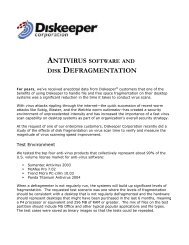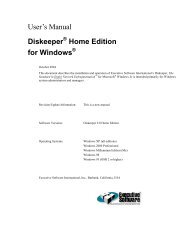Diskeeper 10 User's Manual
Diskeeper 10 User's Manual
Diskeeper 10 User's Manual
Create successful ePaper yourself
Turn your PDF publications into a flip-book with our unique Google optimized e-Paper software.
90 Glossary<br />
single volume, often called drive C:, or it can have several volumes, such as drive C:, drive D:, and drive E:.<br />
See also drive letter, logical drive, partition.<br />
volume set: In Windows, a single logical drive, which is composed of up to 32 areas of free space on one or<br />
more disk drives. Volume sets can be used to combine small areas of free space on one or more disk drives into<br />
a larger logical drive, or to create a single large logical drive out of two or more small disks.<br />
Windows: A family of operating systems, first introduced by Microsoft in 1983, with a graphical user<br />
interface and which ran on MS-DOS based computers. See also Windows 95, Windows 98, Windows NT,<br />
Windows 2000, Windows XP and Windows Server 2003.<br />
Windows 2000: Originally named Windows NT 5.0, Windows 2000 is a family of operating systems for<br />
desktop computers and network servers, announced by Microsoft in 1998. Windows 2000 resembled Windows<br />
NT 4.0 and Windows 98, but had many enhancements and new features. Windows 2000 is available in several<br />
editions, ranging from Windows 2000 Professional to Windows 2000 Advanced Server.<br />
Windows 95: A version of Windows released in 1995. New features in Windows 95 with regard to its<br />
predecessor, Windows 3.1, included a new user interface and support for 32-bit applications. See also OSR 2.<br />
Windows 98: Successor to the Windows 95 operating system, Windows 98 featured support for the FAT32 file<br />
system, greater Internet integration, and support for the latest (at the time) hardware developments.<br />
Windows Me: Short for Windows Millennium Edition, an operating system released by Microsoft in<br />
September 2000. Successor to Windows 98 and designed for home use, Windows Me offers enhancements in<br />
the areas of digital media, user interface, home networking, and the Internet.<br />
Windows NT: An operating system released by Microsoft in 1993 (NT stands for New Technology.) It has a<br />
similar graphical user interface to Windows, but it does not run over MS-DOS and was designed specifically<br />
for computer network environments.<br />
Windows Server 2003: An operating system released by Microsoft in 2003 as the follow-up version to<br />
Windows 2000 Server. Like its predecessor, it has a similar graphical user interface to Windows, but it does not<br />
run over MS-DOS and has been designed specifically for computer network environments. Windows Server<br />
2003 is available in Standard, Web, Enterprise, and Datacenter editions.<br />
Windows XP: An operating system released by Microsoft in 2001 as the follow-up version to Windows 2000.<br />
Like its predecessor, it has a similar graphical user interface to other Windows versions, but it does not run<br />
over MS-DOS and has been designed specifically for computer network environments. Windows XP is<br />
available in several editions for different uses, such as Windows XP Professional for corporate use, or<br />
Windows XP Home Edition for home users.<br />
workgroup: In Windows NT, Windows 2000, Windows XP, or Windows Server 2003, a workgroup consists of<br />
one or more computers that do not participate in a domain and are therefore responsible for their own security<br />
and administration.<br />
workstation: A computer that has been set up for use by an individual typically connected to a network. The<br />
term is also used to indicate a client computer, in contrast with a server.<br />
x86: Symbol to represent a series of CPUs, manufactured by Intel and others, including model numbers 8086,<br />
80286, 80386, 80486 and 80586 (Pentium). All of the CPUs in this series have certain characteristics in<br />
common, which permits software to be written that will run on any of them.






